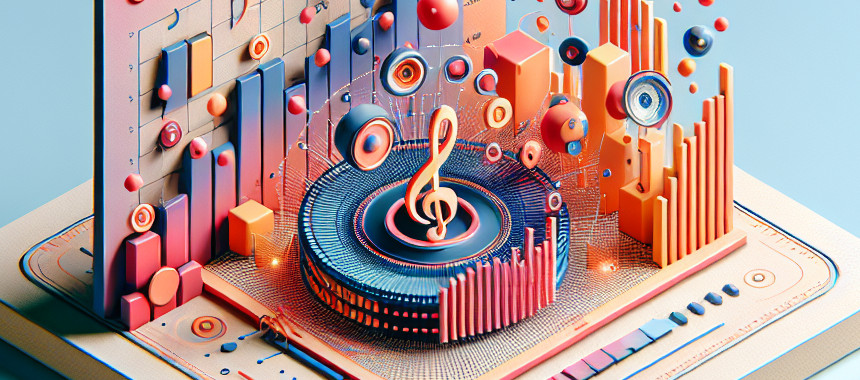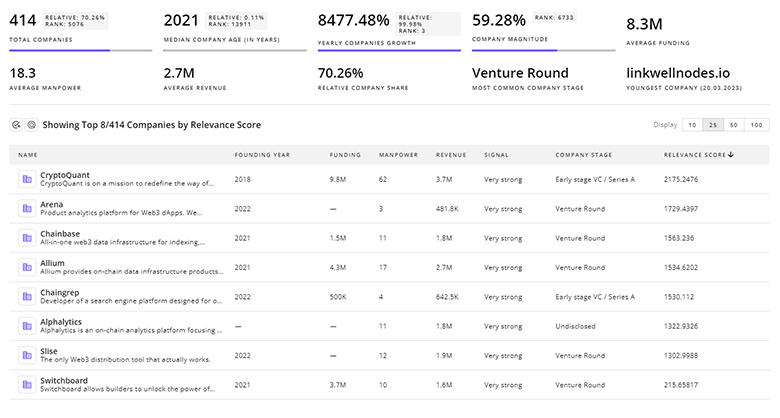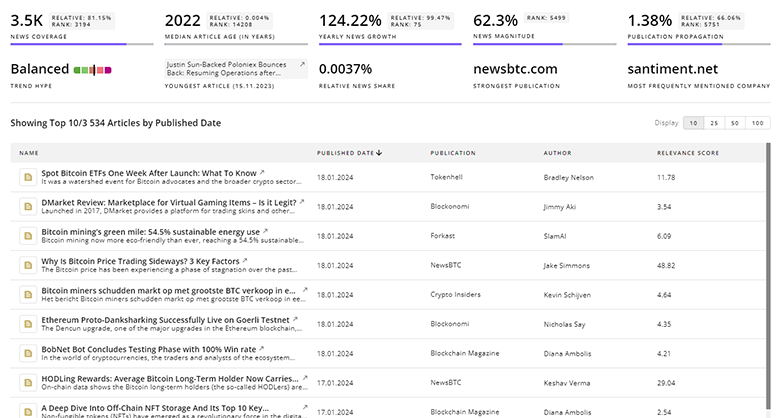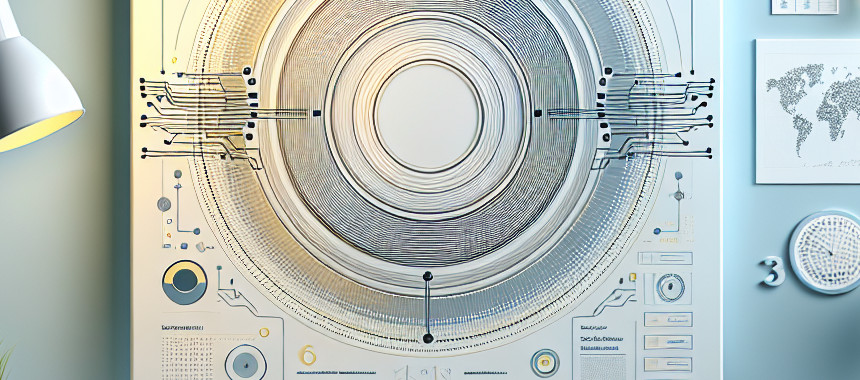
AI Music Report
: Analysis on the Market, Trends, and TechnologiesThe AI music market is accelerating into commercial scale, driven by personalization and production automation; the internal trend data projects a compound annual growth rate of 23.5% and forecasts a market size of $10.43 billion by 2029. Automated composition and stem-processing tools are already capturing significant attention in 2024 and social platforms are amplifying AI tracks into mainstream consumption. This combination of high growth, rapid feature adoption, and unresolved rights questions creates both sizeable commercial opportunity and regulatory risk for incumbents and startups alike.
This report was last updated 4 days ago. Spot an error or missing detail? Help us fix it by getting in touch!
Topic Dominance Index of AI Music
To identify the Dominance Index of AI Music in the Trend and Technology ecosystem, we look at 3 different time series: the timeline of published articles, founded companies, and global search.
Key Activities and Applications
- Automated music composition from text prompts and short-form seeds, used for background music, content creator tools, and quick ideation.
- Audio source separation and stem manipulation for remixing, licensing, and archival restoration; this function commands premium value in professional workflows Artificial Intelligence (AI) in Music Market - Forecasts from 2024 to 2029.
- Real-time, context-aware generative soundtracks for gaming, livestreaming, and interactive media; systems respond to gameplay or viewer input to produce continuous, copyright-safe music streams.
- AI vocal synthesis and "custom singer" tools that convert MIDI/lyrics into expressive vocals, enabling producers to create finished vocal tracks without traditional session singers.
- Rights management, licensed training datasets, and attribution tooling to enable compliant model training and monetization arrangements between rights holders and AI platforms Musical AI Universal says struck first licensing deal for AI music.
Emergent Trends and Core Insights
- Social amplification drives rapid A&R cycles: short-form platforms accelerate discovery, making low-cost AI tracks viable viral assets and increasing demand for fast, royalty-safe composition tools AI in Music Market Size, Share, Trend | CAGR of 27.8%. > So what: Platforms that integrate direct publishing to social channels and optimized metadata win distribution and usage velocity.
- Monetization friction from IP exposure: independent analysis estimates up to 23% of creators' revenues could face pressure by 2028 from generative competition and unclear licensing Largest report on AI in music reveals devastating impact. > So what: Companies that offer transparent revenue-share models and provable provenance for training assets will attract rights holders and reduce legal tail risk.
- Ingredient vs platform split: market dynamics favor firms that control high-leverage audio science (source separation, high-fidelity synthesis, metadata provenance) while generalist consumer apps risk rapid feature parity Adaptive Analysis Framework Determination. > So what: Strategic buyers will pay premiums for defensible IP and integrated APIs that embed into DAWs and content pipelines.
- Cost and production efficiency become adoption levers: case studies report production cost and turnaround reductions up to 70% when media firms adopt AI-assisted pipelines AI in Music Production: Key Trends Shaping the Future beyond 2025. > So what: Enterprise sales motions should quantify time-to-release and per-track cost improvements to win studio and agency budgets.
- Technical focus moves from single-clip generation to long-form coherence, emotional conditioning, and local/offline models to address privacy and reliability Generate Music with AI Locally Using ACE-Step A Novel Framework for Automatic Music Generation Using Hybrid AI Techniques. > So what: Products that offer controllable structure editing and on-device inference will gain trust from professional users and regulated customers.
Technologies and Methodologies
- Transformer-based sequence models tuned for long-range musical structure and lyrics-to-melody conditioning Generative Artificial Intelligence (AI) in Music Market 2025.
- Diffusion and masked-autoencoder approaches for high-fidelity audio synthesis, used where professional-grade timbre and mix realism matter.
- Neural source separation and perceptual audio representations to produce clean stems for remixing and licensing workflows Music AI.
- Reinforcement learning and feedback-driven optimization to tailor adaptive accompaniment and performance tutoring systems.
- Compact on-device models and spiking neural network experiments to enable low-latency, energy-efficient music agents in consumer hardware and games AiRAES Musifier.
AI Music Funding
A total of 171 AI Music companies have received funding.
Overall, AI Music companies have raised $5.7B.
Companies within the AI Music domain have secured capital from 684 funding rounds.
The chart shows the funding trendline of AI Music companies over the last 5 years
AI Music Companies
- Infinite Album — Creates continuous, game-reactive generative music streams branded as "Vibes" for livestreamers and gamers; emphasizes copyright-safe, interactive soundtracks that viewers can influence and monetize, making it a targeted solution for streaming ecosystems and game studios.
- Why it matters: directly addresses the large and growing creator market that needs always-on, non-infringing music for live content.
- DAACI — Builds patented dynamic and adaptive composition plugins aimed at professional composers and interactive media; holds a deep IP portfolio (dozens of patents) that targets real-time composition and smart editing for media workflows.
- Why it matters: DAACI represents an "ingredient" play with defensible technology that integrates into production pipelines where fidelity and control command premium pricing.
- Klangio — Focuses on high-accuracy automatic music transcription to sheet music and MIDI, serving educators, arrangers, and studios that require notation rather than raw generation.
- Why it matters: transcription fills a professional utility gap that generalist generators do not address, creating a narrow but strong commercial moat.
- AIDAR — Offers AI-driven A&R and talent scouting with a database of over 3 million artists; targets indie labels and A&R teams with recommendation models designed to surface commercially promising acts.
- Why it matters: A&R intelligence shifts AI influence upstream in the music value chain and creates commercial hooks with labels and publishers.
- Timedomain (ACE Studio) — Provides advanced vocal synthesis that converts MIDI and lyrics into expressive, royalty-free AI singers and supports custom voice training; targets producers who need finished vocal tracks without traditional sessions.
- Why it matters: high-fidelity vocal synthesis directly addresses a pressing production bottleneck and can substitute costly vocal sessions for many applications.
Identify and analyze 1.1K innovators and key players in AI Music more easily with this feature.

1.1K AI Music Companies
Discover AI Music Companies, their Funding, Manpower, Revenues, Stages, and much more
AI Music Investors
TrendFeedr’s investors tool offers a detailed view of investment activities that align with specific trends and technologies. This tool features comprehensive data on 909 AI Music investors, funding rounds, and investment trends, providing an overview of market dynamics.

909 AI Music Investors
Discover AI Music Investors, Funding Rounds, Invested Amounts, and Funding Growth
AI Music News
Stay informed and ahead of the curve with TrendFeedr’s News feature, which provides access to 2.8K AI Music articles. The tool is tailored for professionals seeking to understand the historical trajectory and current momentum of changing market trends.

2.8K AI Music News Articles
Discover Latest AI Music Articles, News Magnitude, Publication Propagation, Yearly Growth, and Strongest Publications
Executive Summary
The AI music sector offers materially attractive growth driven by personalization, cost efficiencies in production, and platform-enabled distribution. The commercial winners will not be those that only generate music, but those that secure scarce inputs and embed into professional workflows: data provenance and licensing, high-quality source separation, reliable long-form generation, and low-latency synthesis. Rights clarity and transparent monetization will determine whether incumbents integrate AI models into existing catalogs or pause adoption until legal frameworks firm up. For investors and product leaders, the highest-return plays focus on ingredient technologies and enterprise integrations that professional creators and media companies cannot replicate easily, while consumer-facing features will face fast commoditization and consolidation.
Interested in enhancing our coverage of trends and tech? We value insights from experts like you - reach out!













